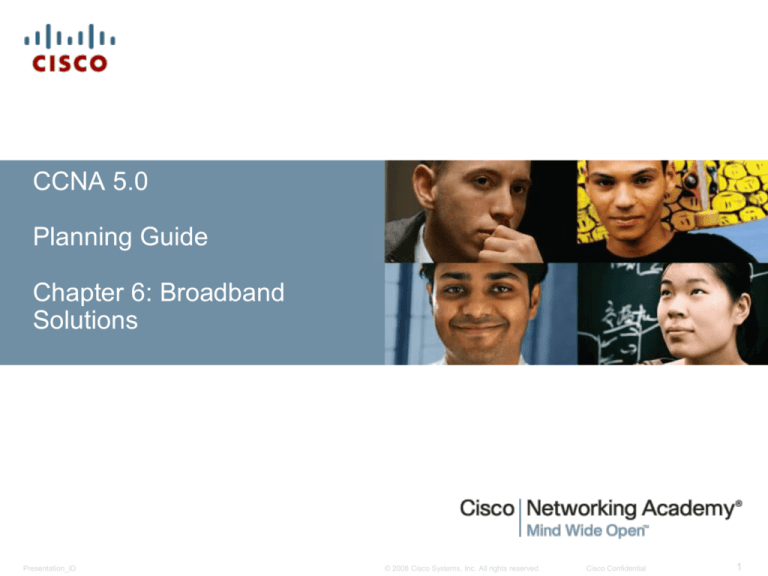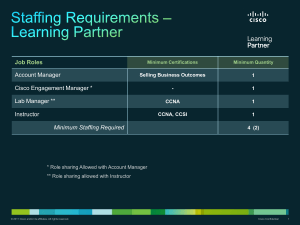
CCNA 5.0
Planning Guide
Chapter 6: Broadband
Solutions
Presentation_ID
© 2008 Cisco Systems, Inc. All rights reserved.
Cisco Confidential
1
Chapter 6: Objectives
Determine how to select broadband solutions to support remote
connectivity in a small-to-medium-sized business network.
Explain the benefits of teleworking solutions.
Describe the business requirements of teleworking.
Describe a cable system and cable broadband access.
Describe a DSL system and DSL broadband access.
Describe broadband wireless options.
Compare broadband solutions.
Configure and verify a basic PPP over Ethernet connection on a
client router.
Presentation_ID
© 2008 Cisco Systems, Inc. All rights reserved.
Cisco Confidential
2
Chapter 6: Overview
This chapter:
Introduces broadband solutions that provide remote office staff and
small office, home office (SOHO) users and access to high-speed
connections to central office locations and to the Internet
Outlines the features and basic infrastructure behind each
broadband technology
Examines the broadband solutions (DSL, cable, and broadband
wireless)
Explains basic DSL configuration
Presentation_ID
© 2008 Cisco Systems, Inc. All rights reserved.
Cisco Confidential
3
Chapter 6: Activities
What activities are associated with this chapter?
6.0.1.2 Class Activity – Broadband Varieties
6.1.1.6 Activity – Benefits of Teleworking
6.1.2.3 Activity – Classify Requirements for Teleworker
Connectivity
6.2.1.5 Activity – Identify Cable Terminology
6.2.2.4 Activity – Identify DSL Terminology
6.2.3.3 Activity – Identify Broadband Wireless Terminology
Presentation_ID
© 2008 Cisco Systems, Inc. All rights reserved.
Cisco Confidential
4
Chapter 6: Activities (cont.)
What activities are associated with this chapter?
6.2.4.2 Lab – Researching Broadband Internet Access
Technologies
6.3.2.2 Syntax Checker – Configuring PPPoE
6.3.2.3 Lab – Configuring a Router as a PPPoE Client for DSL
Connectivity
6.4.1.1 Class Activity – Telework Proposal
Presentation_ID
© 2008 Cisco Systems, Inc. All rights reserved.
Cisco Confidential
5
Chapter 6: Packet Tracer Activity Password
The password for all the Packet Tracer activities in this chapter is:
PT_ccna5
Presentation_ID
© 2008 Cisco Systems, Inc. All rights reserved.
Cisco Confidential
6
Chapter 6: Assessment
Students should complete Chapter 6 Exam after completing
Chapter 6.
Worksheets, labs and quizzes can be used to informally assess
student progress.
Presentation_ID
© 2008 Cisco Systems, Inc. All rights reserved.
Cisco Confidential
7
Chapter 6: New Terms
What terms are introduced in this chapter?
6.1.1.
6.1.2.1
6.2.1.1
6.2.1.2
6.2.1.3
6.2.1.4
6.2.2.1
Presentation_ID
Teleworking
Virtual Private Network (VPN)
Ipsec Vpns
Hybrid Fiber-coaxial (HFC) Networks
Downstream
Upstream
Data-over-cable Service Interface Specification (DOCSIS) Frequencydivision Multiple Access (FDMA)
Code Division Multiple Access (CDMA)
S-cdma
Euro-docsis
Cable Modem Termination System (CMTS)
Cable Modem (CM)
HFC Network
DSL
ADSL
SDSL
Plain Old Telephone Service (POTS)
© 2008 Cisco Systems, Inc. All rights reserved.
Cisco Confidential
8
Chapter 6: New Terms (cont.)
What terms are introduced in this chapter?
6.2.2.2
6.2.2.3
6.2.3.1
6.2.3.2
Presentation_ID
Cpe
DSL Access Multiplexer (DSLAM)
Central Office (CO)
Aggregation Router
Transceiver
Demarcation Point
Network Interface Device (NID)
Microfilter
POTS Splitter
Municipal Wi-fi (Mesh)
Worldwide Interoperability For Microwave Access (Wimax)
3G/4G Wireless
Long-term Evolution (LTE)
One-way Multicast
One-way Terrestrial Return
Two-way Satellite Internet
Very Small Aperture Terminals (VSAT)
© 2008 Cisco Systems, Inc. All rights reserved.
Cisco Confidential
9
Chapter 6: New Terms (cont.)
What terms are introduced in this chapter?
6.3.1.1
Point-to-Point Protocol (PPP)
PPP over Ethernet (PPPoE)
6.3.2.1
interface dialer number command
dialer pool command
pppoe-client command
Maximum Transmission Unit (MTU)
Presentation_ID
© 2008 Cisco Systems, Inc. All rights reserved.
Cisco Confidential
10
Chapter 6: Best Practices
The instructor should:
Make this chapter as hands-on as possible.
Encourage students to do the chapter activities, labs, and use the
Syntax Checker.
Use the lab researching Broadband Internet Access Technologies as
a group activity assigning a technology to a group and have students
present their findings.
Video outlining Teleworking advantages:
http://www.youtube.com/watch?v=o7XWpRslF0Y
Telework research and statistics:
http://www.globalworkplaceanalytics.com/whitepapers
Configuring DSL:
https://www.youtube.com/watch?v=HBP8_LqBj44
Presentation_ID
© 2008 Cisco Systems, Inc. All rights reserved.
Cisco Confidential
11
Chapter 6: Additional Help
For additional help with teaching strategies, including lesson plans,
analogies for difficult concepts, and discussion topics, visit the
CCNA Community at http://community.netacad.net/web/ccna/files.
If you have lesson plans or resources that you would like to share,
upload them to the CCNA Community to help other instructors.
Presentation_ID
© 2008 Cisco Systems, Inc. All rights reserved.
Cisco Confidential
12
Chapter 6: Topics Not in ICND2 200-101
This section lists topics covered by this chapter that are NOT listed
in the ICND2 200-101 Blueprint. Those topics are posted at:
http://www.cisco.com/web/learning/exams/list/icnd2b.html
Instructors could skip these sections; however, they should provide
additional information and fundamental concepts to assist the
student with the topic.
Presentation_ID
© 2008 Cisco Systems, Inc. All rights reserved.
Cisco Confidential
13
Chapter 6: Topics Not in ICND2 200-101
What sections of this chapter are NOT in the ICND2 200-101
certification blueprint?
Presentation_ID
6.1
Teleworking
6.2
Comparing Broadband Solutions
6.3.1
PPPoE Overview
6.4
Summary
© 2008 Cisco Systems, Inc. All rights reserved.
Cisco Confidential
14
Presentation_ID
© 2008 Cisco Systems, Inc. All rights reserved.
Cisco Confidential
15
Presentation_ID
© 2008 Cisco Systems, Inc. All rights reserved.
Cisco Confidential
16






